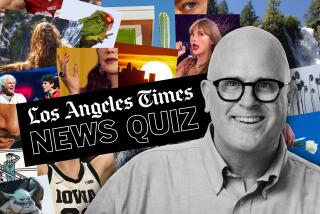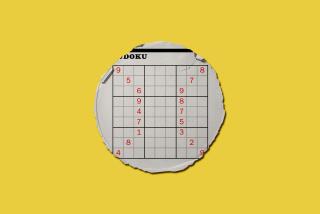COLUMN ONE : The ABCs of Across and Down : For nearly 80 years, millions of Americans have puzzled over crosswords. But some say the game is in trouble, as archaic clues and answers turn off younger solvers.
- Share via
Here is Jon Delfin, crossworder extraordinaire, and he can do something that would make the average puzzle solver blink in disbelief.
As a diversion, he works crosswords using only one set of clues, the ones in the “down” column. Just to stay sharp, mind you. Makes it more of a challenge.
But, hey, this guy’s the best, the A.J. Foyt of crossword puzzle solvers. He’s won the American Crossword Puzzle Championship for the last three years and will be on hand again when the three-day event opens today in Stamford, Conn.
What that means is that Delfin, 37, a New York City piano man--player, not tuner--is the best of those who turn to the crossword every day on trains, subways, buses and at the breakfast table. He can work a puzzle in four minutes. Faster if it’s an easy day.
So what’s he doing to get ready for the big event? Like most puzzle solvers, absolutely nothing.
“There’s nothing I do that resembles training,” said Delfin, who definitely has what Aretha Franklin wanted most (r-e-s-p-e-c-t) from those who take their crossword puzzles seriously.
That is a very large group, indeed. According to a study done in 1988 by the Newspaper Advertising Bureau, 26% of the people who buy newspapers at least look at the crossword puzzle. Another estimate is that more than 40 million Americans regularly puzzle over crosswords.
“It has the appeal of a good mystery, a problem to be solved,” said Will Shortz, the editor of Games magazine and a sponsor of the national championship. “We can take the solution all the way to the end by ourselves. We can fill in that last square.”
But all is not idyllic in the world of the crossword. Those who follow the business closely say that the majority of crossword addicts now have streaks of gray in their hair and that many of the puzzles printed each day are out of touch with new, younger puzzle solvers who couldn’t care less about the genus of the fruit fly.
“Virtually no one under the age of 50 is doing crosswords,” said Stanley Newman, the puzzle editor for Long Island’s Newsday, who loses no opportunity to rail about the state of the nation’s puzzledom. “There’s almost no research done about what puzzles are all about. And there is no feature so at odds with what a newspaper is supposed to be.”
Newman contends, among other things, that a newspaper puzzle should first of all be current. And, he said, it should emphasize cleverness in clues and perhaps provide a bit of mirth when the solver finally figures out the answers. For him, a “bet middler” is a bookie.
Newman, like other so-called “new wavers,” is adamant that puzzles should not contain out-of-date and rarely used words and phrases. Rather, they should reflect the events and words of today’s world. As an example of what they should not be, Newman produced the Feb. 19, Los Angeles Times puzzle, in which the following words were answers: rete, pili, orc, esc, cerate, alar, coele, ani and ret.
“There should be almost no words that wouldn’t be used in conversation,” Newman scolded.
Eric Albert, who specializes in creating crosswords using a computer program, agreed with Newman, saying that with enough care, arcane words could be eliminated from puzzles. He cited his “aril rule” as an example of how people who do puzzles have developed their own specialized vocabulary from years of solving them.
“All you’ve got to do is walk down the street and ask people a word for ‘seed covering.’ If they say ‘aril,’ they do crosswords. If they look at you like you’re crazy, they don’t do crosswords,” he said.
The crossword will turn 80 next year, but it is a descendant of word games that go back centuries. The ancient Egyptians had games in which the answers were revealed when words were strung together correctly. John Calvin and Francois Rabelais used anagrams of their names as pseudonyms.
According to “The Compleat Cruciverbalist,” a book about crosswords, the oldest known “word square” dates back to the 1st Century AD. The words could be read row by row, column by column, forward and back and have the same meaning. The phrase in the square, translated from the Latin, means “God watches over the universe.”
The first real crossword puzzle made its debut in late 1913 when Arthur Wynne, the puzzle page editor of the New York World, decided to try something different. The resulting “Word Cross,” as it was called, with 15 words across and 16 down, was a major sensation. In what was a forerunner of puzzles to come, one clue was “fiber of the gomuti palm.” The answer, of course, was “doh.”
At some point in the early going, typesetters transposed the words in “Word Cross” and the rest is, as they say, important enough to be recorded (h-i-s-t-o-r-y).
In 1924, two New Yorkers named Dick Simon and Max Shuster made a book of crosswords their first publishing venture. They were so afraid their idea might provoke hoots of derision that the book--the first of its kind--was printed with the name of a bogus publisher. As it turned out, the book was a tremendous success and Simon & Shuster went on to become one of the country’s great publishing houses.
Crossword puzzles turned into a craze during the ‘20s. According to newspaper accounts at the time, one woman in Cleveland was granted a divorce because her husband would do nothing but work crosswords from morning to night. Another man was arrested for disturbing the peace because he would not leave his restaurant seat until he finished his puzzle. A New York telephone company worker shot and wounded his wife because she would not help him with the crossword. The man then killed himself.
Women’s clothes were designed in the pattern of the crossword. Railroads began furnishing dictionaries in their club cars as an aid to traveling cross-worders.
The New York Times reported an incident in which a mob descended in the Carnegie Library in Pittsburgh, Pa., demanding to know the answer to the clue of “a bird of the suborder of eleutherodactyli oscines .” The answer, of course, was “sparrow.”
Two prisoners got in a fistfight because they could not agree on whether a “place of punishment” was “cell” or “hell.” A smash Broadway play was called “Puzzles of 1925,” and one of the favorite songs of the day was “Cross Word Mama, You Puzzle Me (But Papa’s Gonna Figure You Out).”
According to the book “What’s Gnu?” a British crossword constructor came under heavy scrutiny during World War II when his puzzles appearing in the Daily Telegraph contained a number of the code words for the Allied invasion of Normandy.
One of the major events in the annals of crosswordism came in 1942, when the stodgy New York Times finally succumbed and began publishing its now-famous Sunday puzzle, with smaller crosswords in the daily editions beginning in 1950.
Since then, there have only been three puzzle editors at the Times, Margaret Farrar, Will Weng and Eugene Maleska, who assumed the title in 1977.
Although it has its detractors, the Times puzzle has long been the dominant daily crossword of the country. Millions of people are addicted to the puzzles, which gradually become more difficult as the week progresses, with Saturday’s being nearly impossible to all but the most dedicated crossworders. Then comes the Sunday offering, which constructor Merl Reagle of Santa Monica calls “the showcase puzzle in America.”
People like Newman and Reagle fault Maleska for being somewhat old-fashioned and humorless with his puzzles. And Maleska, in reply, contends that the Times remains a crossword trendsetter. He refers to those who snipe at him as a swarm of “gnats biting at me,” and acidly in puzzles calls the “new wave” the “new ripple.”
So how is life at the top of the crossword heap?
“It’s great except for people like that,” he says of his critics.
The actual construction of a puzzle is something that often takes long hours, particularly if there is a theme embedded in the clues.
“I can solve a puzzle in four minutes, but it might take me four hours to construct one,” said Delfin, the puzzle-solving champ.
Reagle, whose puzzles appear in the San Francisco Examiner, said there is a basic set of rules to follow in the building of a crossword. The black squares must be filled in so that the puzzle looks the same when turned upside down. No more than one-sixth of the squares can be black. Words must be three letters or longer and no words can be isolated from the rest of the puzzle by being surrounded with black squares.
He also said some things are generally taboo in crosswords. Some companies that publish puzzle books shy away from using words like “bra” and the names of controlled substances for fear of upsetting puzzlers in the Bible Belt. Ale and rum are the outer edge of respectability for those puzzles.
Reagle also said great care must be taken in developing the theme answers because they must take up exactly the same number of squares at the opposite ends of the puzzle.
Finally, said Reagle, there is the matter of crosswording, the ability to create words that have a meaning when read both across and down. He said the simplest trick is to start with a word across in which consonants are followed by vowels, such as “general.” Then, in the line underneath that, use a word in which vowels are followed by consonants, such as “average.” By alternating those kinds of words, it is usually possible to build a puzzle that reads down as well as across.
“If you’re able to make a crossword, that’s just the ground floor,” he said. “And if you can make a crossword without the boring words, then you’re really something.”
Reagle made the news last year when he came to the aid of an ardent crossworder, Neil Nathanson of Palo Alto, who was in love with another puzzle addict, Leslie Hamilton. The request from Nathanson was to design a puzzle that would contain a marriage proposal. Reagle did him one better last November and built the proposal into the Sunday Examiner puzzle. Then he shaded in some of the answers of the crossword that Hamilton herself was to puzzle over.
When she had finished, the shaded areas said, “Dear Leslie, will you marry me, Neil.” She accepted. Reagle is on the guest list.


